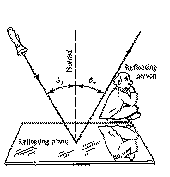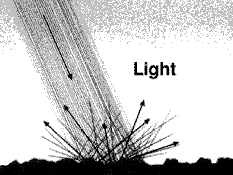
Geometrical Optics

 Reflection
Reflection
 Reflection
Reflection



 Reflection
Reflection

|
When light traveling in a given direction hits a smooth surface
obliquely, (latin obliquus, not at right angles) it is reflected in some different direction. The direction of the reflected light is determined by the
 angle of reflection, angle of reflection,
 angle of incidence, angle of incidence,
 Law of reflection Law of reflection

The law of reflection describes how a plane mirror forms images. Reflection creates an
 Image
ImageThe apparent image is very important when designing optical equipment. Tutorial:Construct the image in a plane mirror |
 Multiple Reflections
Multiple Reflections
A single mirror can form several images of an object (e.g. a candle).
Since most mirrors have a glass surface covering the reflecting silver,
one can get several reflections from the mirror. Most light is
reflected from the silver, but some is reflected from the front
glass surface.
 Corner Mirrors Corner Mirrors
The interesting thing about these perpendicular mirrors is this: No matter what the direction of incidence, the light always is reflected back into the same direction (at least for light in the plane of the paper). No matter from where you look into the corner, you always see yourself. Such a corner mirror does not reverse right and left. Try 3 plane mirrors! Such a device reflects all incoming rays.
|
 Retroreflector Retroreflector
 Kaleidoscopes Kaleidoscopes
 Diffuse Reflection Diffuse Reflection
 Example: Compare driving at night on a dry road and on a wet road.
|

Ch. Elster